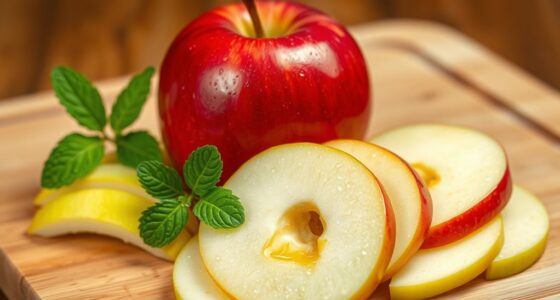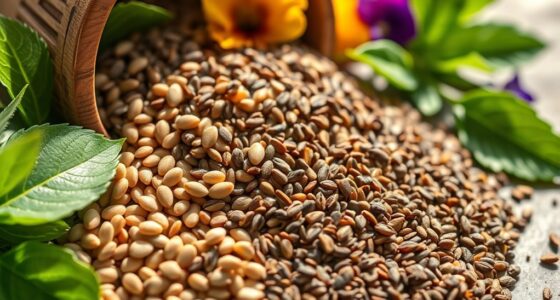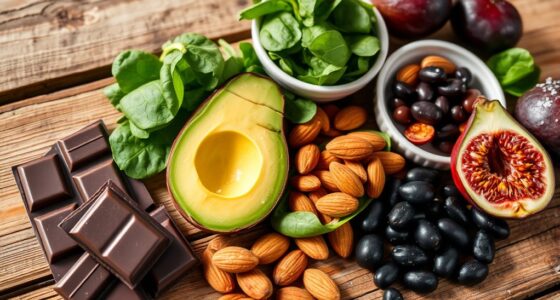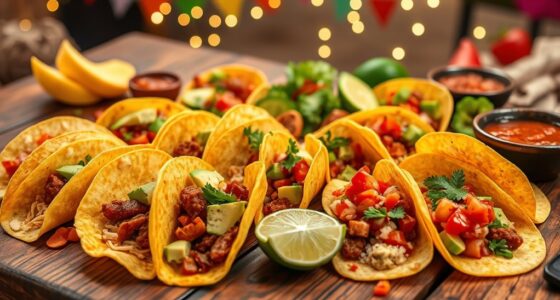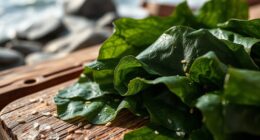Foraging is the new culinary trend that brings wild ingredients to your plate, making meals more exciting and sustainable. You’ll discover vibrant edible plants like dandelion and burdock that not only enhance flavor but also boost nutrition. With the rise of community foraging groups and online resources, it’s easier than ever to learn the ins and outs of gathering these natural treasures. Keep exploring, and you’ll uncover even more tasty foraging tips and delicious recipes!
Key Takeaways
- Foraging enhances culinary experiences, providing unique flavors and ingredients that elevate dishes in high-end restaurants.
- It promotes sustainability by connecting eaters with nature and supporting local ecosystems.
- Foraged plants like dandelion and burdock offer significant nutritional benefits, enriching diets with vitamins and minerals.
- Community workshops and online platforms foster engagement and knowledge sharing, making foraging accessible and enjoyable.
- Awareness of local regulations and safe identification practices ensures foraging is both legal and safe for all enthusiasts.
The Rise of Foraging in Culinary Culture
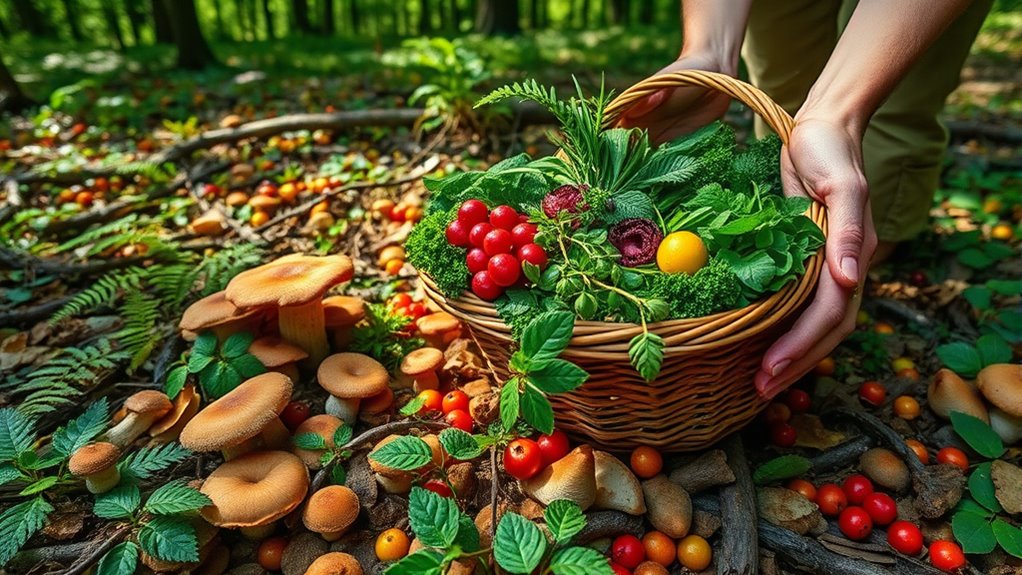
As foraging gains traction in culinary culture, chefs are increasingly turning to wild ingredients to amplify flavors and promote sustainability.
This trend is reshaping menus in high-end restaurants, where foraged items bring unique tastes that elevate dishes. You might notice these ingredients celebrated in notable publications like The New Yorker and The Washington Post, emphasizing their cultural relevance.
With the rise of foraging, classes and workshops are popping up, inviting you to learn how to identify and prepare edible plants in various environments. This movement aligns with the broader interest in non-perishable items that support sustainable and self-sufficient living.
This movement is part of a broader foodie culture that prioritizes high-quality, locally sourced foods. Foraging connects you with nature and diversifies your diet with sustainable food options, making it an appealing choice for conscious eaters.
Exploring Edible Plants and Their Benefits
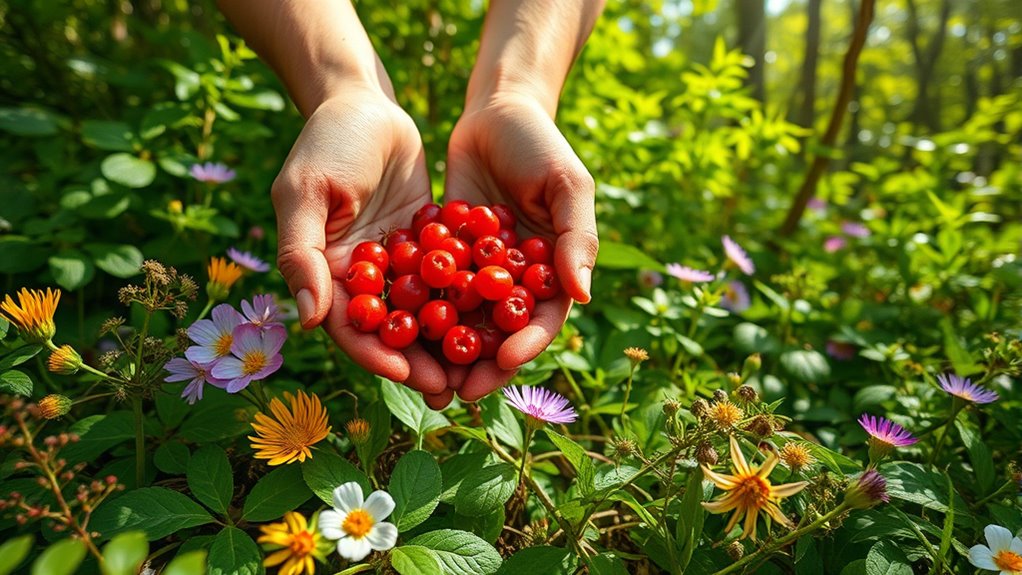
When you explore edible plants, you’ll discover a treasure trove of nutrition and unique flavors right in your backyard. These wild foods not only enhance your meals but also offer seasonal foraging opportunities that can elevate your culinary skills. Let’s uncover the benefits of incorporating these plants into your diet and how to prepare them in tasty ways. Additionally, sustainable harvesting practices are essential to ensure that wild edible populations remain healthy for future generations. Understanding the foraging range of local bees can also help you appreciate the interconnectedness of wild plants and the pollinators that support them. It’s important to note that many wild edible plants, like broccoli farming tips, can provide an excellent source of vitamins and minerals when foraged correctly, just as homegrown chia seeds are rich in Omega-3 fatty acids and other essential nutrients. Moreover, incorporating antioxidant-rich foods into your diet can significantly contribute to your overall health.
Nutritional Value of Foraged Plants
Foraging for wild foods can be a rewarding experience, not just for the thrill of the hunt but also for the incredible nutritional benefits these plants offer.
Here are some highlights on the nutritional value of foraged plants:
- Dandelion leaves: Packed with vitamins A, C, and K, they’re a great addition to salads or stir-fries.
- Broadleaf dock: After boiling water to reduce oxalic acid, it provides dietary fiber and supports liver health.
- Cleavers: Rich in vitamins and minerals, they’ve been used for their diuretic properties and can enhance broths.
- Burdock root: High in inulin, it helps regulate blood sugar and adds essential nutrients to soups.
Eating wild not only connects you with nature but also enriches your diet with these wholesome plants!
Culinary Uses and Recipes
Exploring the culinary uses of wild foods opens up a world of flavors and health benefits that you mightn’t have considered before.
For instance, dandelion leaves are really good in salads and stir-fries, while their roots can be roasted for a coffee substitute.
Broadleaf dock, after boiling for a couple of minutes, makes a great tea believed to support liver function.
Cleavers, typically cooked into broth, have seeds that can also serve as a coffee alternative.
You can toss Siberian miner’s lettuce into fresh salads, and dead nettle adds versatility to any dish.
Burdock’s taproot is nutritious and aids blood sugar concerns.
Every year, thistle proves that even sharp spines can hide delicious, nutritious surprises!
Seasonal Foraging Opportunities
How can you tap into the vibrant world of seasonal foraging? Spring is the perfect time to discover a bounty of wild edibles. Here are some delicious options to explore:
- Dandelions – Harvest the leaves for salads or brew the roots for tea.
- Wild Garlic – Use its fragrant leaves to add zest to dishes.
- Nettles – After boiling to reduce oxalic acid, they make a nutritious soup.
- Burdock – Its taproot is rich in inulin, beneficial for managing blood sugar.
Foraging not only spices up your meals but also fosters community. Additionally, foraging encourages sustainable approaches to food that can enhance your self-reliance in times of need. Share your discoveries and learn from fellow foragers about these local treasures and their culinary uses!
Safeguarding Against Foraging Risks

When foraging, you need to accurately identify plants to steer clear of dangerous look-alikes.
Familiarizing yourself with local foraging regulations is also key, as it helps guarantee you’re picking safe and legal options.
Plant Identification Techniques
Here are some effective strategies to enhance your skills:
- Use Guidebooks: Invest in academic guidebooks with detailed diagrams to accurately identify plants, like wild parsley and poison hemlock.
- Learn Botanical Terms: Familiarize yourself with botanical terminology to improve your understanding of plant characteristics.
- Attend Workshops: Join community workshops or foraging classes led by experienced foragers for hands-on experience.
- Forage Cleanly: Always forage in clean environments and wash all plants thoroughly before consumption to reduce contamination risks.
- Practice Safe Foraging Techniques: Incorporate regular cleaning schedules to ensure your foraging tools and storage areas are kept free of contaminants.
Local Foraging Regulations
While foraging can be an enriching experience, understanding local regulations is essential for both your safety and the environment. Many public parks and protected areas prohibit foraging to conserve native ecosystems, so always check local ordinances before harvesting.
In urban settings, guidelines often exist for foraging in vacant lots and along roadsides due to potential contamination from pollutants. Remember, foraging on private property without permission is illegal and can lead to serious consequences.
Some regions may require permits for collecting certain plants or in specific areas, underscoring the need for awareness. By understanding these regulations, you not only protect the environment but also engage in sustainable practices that benefit your community and the ecosystem.
Getting Started: Tips for Novice Foragers

How can you commence on a successful foraging adventure? Start by arming yourself with the right tools and knowledge. Here are some essential tips for novice foragers:
- Get a Field Guide or App: Invest in a reputable guide focused on edible plants, complete with clear diagrams for safe identification.
- Learn Botanical Terms: Familiarize yourself with terms like “toxic” and “edible” to minimize risks while foraging.
- Find a Mentor: Seek guidance from experienced foragers or join community workshops to gain practical skills.
- Choose Clean Areas: Always forage in unpolluted locations, avoiding areas treated with pesticides or herbicides.
Finally, remember to wash your foraged items thoroughly before enjoying them. Happy foraging!
Urban Foraging: Finding Nature in the City

Urban foraging opens up a world of culinary possibilities right at your doorstep, allowing you to discover edible plants in parks, vacant lots, and even along sidewalks. You might stumble upon dandelions or dead nettle, enhancing your local culinary experiences.
However, it’s essential to know the local ordinances, as foraging is often restricted in public parks to protect native ecosystems. Joining community workshops or local foraging groups can provide you with hands-on experience and safe foraging practices.
Keep in mind that urban pollutants can affect plant safety, so always choose clean areas and wash your finds thoroughly before consuming them. By foraging, you contribute to sustainability, promoting fresh, wild ingredients that align with today’s foodie culture.
Seasonal Foraging: What to Look For
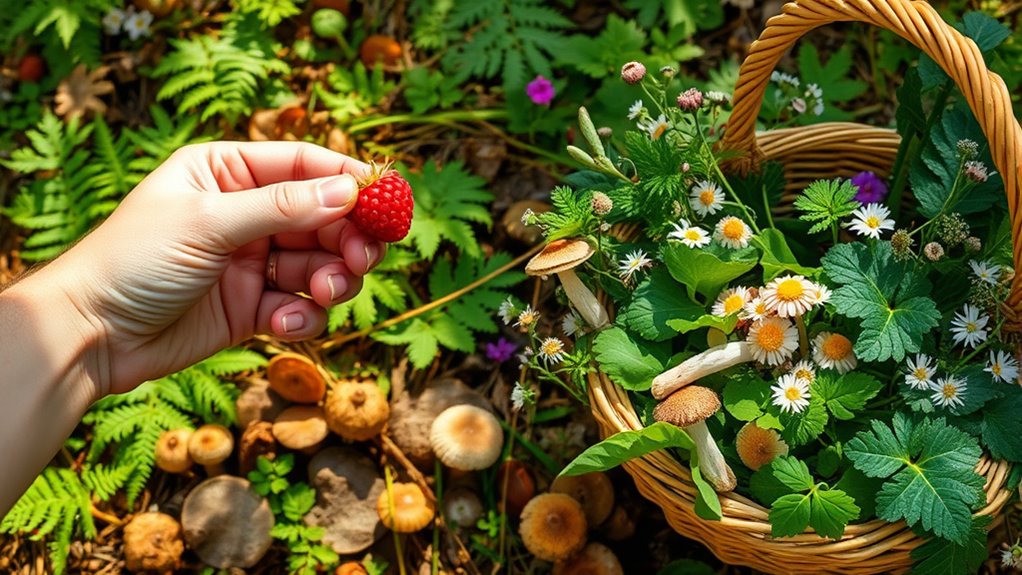
As spring unfolds, a vibrant tapestry of wild edibles emerges, inviting you to explore the bounty of nature.
This season is perfect for foraging, with a variety of delicious plants waiting for you to discover. Here’s what to look for:
- Dandelion: Enjoy the leaves fresh in salads or roast the roots for a coffee substitute.
- Broadleaf Dock: Boil for 2-3 minutes to make it safe and tasty in various dishes.
- Miner’s Lettuce: This tender green is great for salads and has a mild flavor.
- Wild Garlic: Look for its distinct aroma, and use it to enhance your culinary creations.
Dive into this seasonal adventure, and enrich your meals with nature’s offerings!
Community Engagement and Knowledge Sharing

While foraging can be a solitary adventure, engaging with your community enriches the experience and enhances your knowledge.
Joining local foraging groups or attending workshops offers hands-on experience and fosters collaboration between novice and experienced foragers. Sharing your knowledge about wild edibles can inspire others to explore and appreciate the local flora, promoting sustainable practices.
Online forums and blogs are excellent resources for exchanging tips and identifying edible plants. Additionally, social media allows you to showcase your foraging experiences, motivating others to join the movement.
Delicious Recipes for Foraged Ingredients
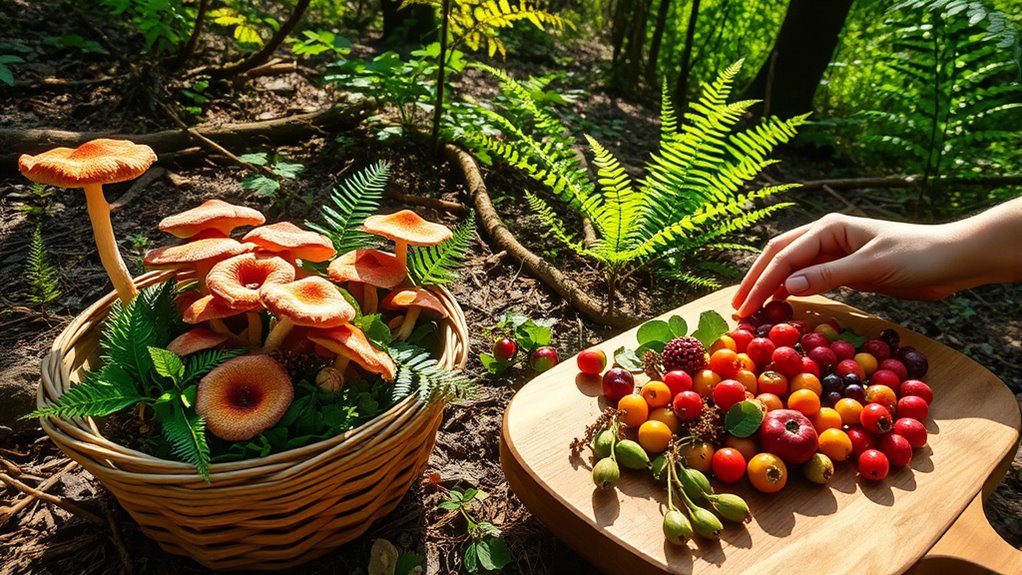
Exploring the culinary potential of foraged ingredients can transform your cooking experience, revealing unique flavors and textures that store-bought items simply can’t match. With just a little creativity, you can elevate your dishes using wild plants. Here are four delicious recipes to try:
- Japanese Knotweed Hot Pickles: Quick-pickle knotweed with vinegar and water for a tangy condiment.
- Elderflower Ice Cream: Blend fresh or dried elderflowers with cream and sugar for a subtly floral dessert.
- Wild Garlic Pesto: Substitute wild garlic for traditional basil to create a unique twist on classic pesto.
- Dandelion Greens Salad: Toss young dandelion leaves with lemon, olive oil, and nuts for a zesty salad.
These recipes highlight simplicity while promoting sustainable, local foraging. Additionally, incorporating foraged ingredients can contribute to sustainable practices that reduce the environmental impact of food sourcing.
Frequently Asked Questions
What Is the Golden Rule of Foraging?
The golden rule of foraging is to positively identify any plant before you eat it. You can’t afford to make mistakes here, as many edible plants have toxic look-alikes.
Always consult reliable guidebooks or experienced foragers to help you guarantee safe identification. Remember to forage in clean areas and wash all your finds thoroughly to remove any contaminants.
Following these steps will keep you safe and make your foraging experience enjoyable.
Is Foraging Unethical?
Foraging isn’t inherently unethical, but it can become problematic if you don’t follow responsible practices. Overharvesting, disrupting ecosystems, and ignoring local laws can harm biodiversity.
Urban foraging also raises concerns about contamination from pollutants. Make sure you respect indigenous lands and their traditions, as taking from these areas without permission can be disrespectful.
What Is It Called When You Find Food in the Wild?
Imagine wandering through a lush forest, where the trees whisper secrets of hidden treasures. That’s what you’re doing when you find food in the wild; it’s called foraging.
It’s more than just gathering; it’s a dance with nature, where you discover edible plants, mushrooms, and fruits. You’re not just feeding your body; you’re nourishing your spirit and reconnecting with the earth.
Just remember, knowing what’s safe to eat is essential for your adventure!
Is Foraging Illegal in the US?
Foraging isn’t universally illegal in the U.S., but its legality depends on where you are. You need to check local laws, as some states allow foraging while others have restrictions to protect ecosystems.
National and state parks often prohibit removing plant life, so always verify the rules before gathering. If you’re in urban areas, stay cautious of potential contaminants in the environment.
Conclusion
As you wander through sun-dappled woods or vibrant city parks, remember that foraging isn’t just about food; it’s about reconnecting with nature. Each wild berry you pluck, each fragrant herb you discover, tells a story of the land and its hidden treasures. Embrace the thrill of the hunt and the joy of sharing your finds. So, grab your basket, breathe in the earthy scents, and let the adventure of foraging ignite your culinary creativity!


